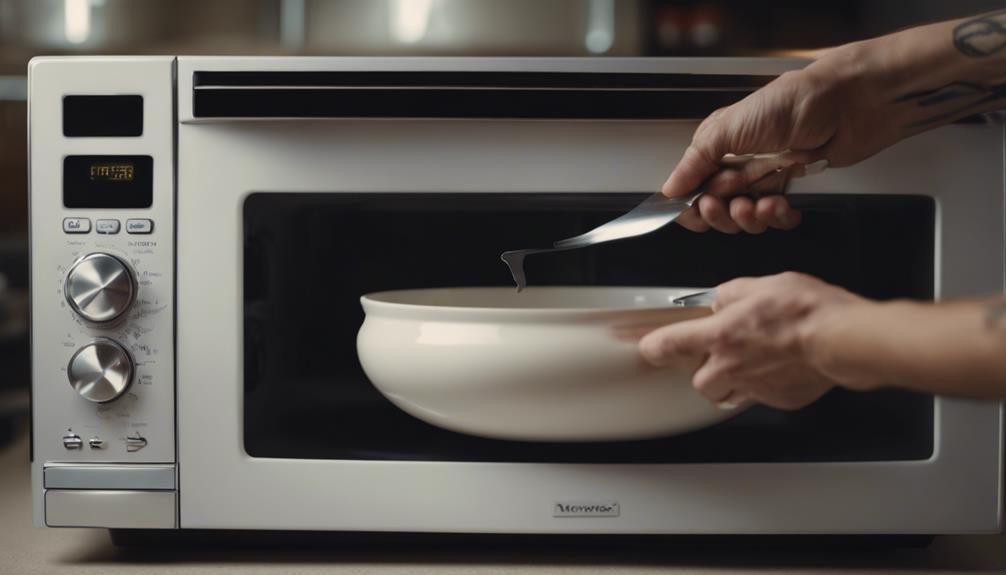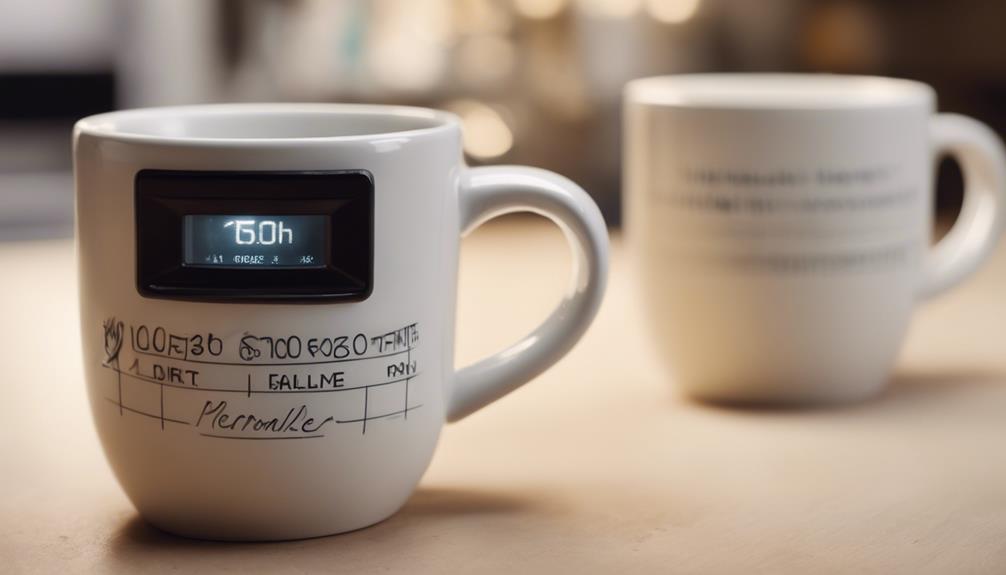Can You Microwave Ceramic
Yes, ceramic dishes can generally be microwaved as long as they are labeled as microwave-safe. However, it is important to check the heat resistance of the specific ceramic dish and follow any additional safety guidelines provided by the manufacturer.
It is also recommended to avoid microwaving ceramic dishes with metallic accents or decorations, as they can cause sparks or damage to the microwave.
Always use caution and follow the instructions to ensure both the safety of the dish and the food being heated.
Key Takeaways
- Look for 'microwave safe' labels or three wavy lines on ceramics for safe use
- Avoid microwaving ceramic dishes with metallic elements to prevent sparking
- Use high-quality ceramics like pottery or stoneware for safe and even heating
- Check water absorption capacity and follow manufacturer's guidelines for optimal microwave use
Types of Ceramic and Microwaving Safety
When considering microwave safety with ceramic, understanding the types of ceramic materials used in tableware is essential for proper heating procedures.
Always look for the 'microwave safe' label or three wavy lines at the bottom of ceramic dishes before microwaving. Modern ceramic plates and bowls made of pure clay and fired at high temperatures are generally suitable for microwaving.
However, avoid microwaving ceramic dishes with gilding or metallic elements, as they may not be compatible with microwaves. Additionally, consider the water absorption capacity of ceramics to determine safe heating times.
It is advisable to choose trusted brands for ceramic tableware and refrain from stacking dishes in the microwave to uphold safety precautions during the heating process.
Common Ceramic Materials in Microwaves
Ceramic materials commonly found in microwaves include pottery, porcelain, terracotta, and stoneware, known for their heat resistance and suitability for microwave use.
These ceramic dishes are often labeled as 'microwave safe' or bear three wavy lines at the base, indicating their compatibility with microwave heating.
The heat resistance of pottery and stoneware makes them ideal for withstanding microwave temperatures. However, it is essential to avoid microwaving ceramic items with metallic finishes, as these may cause sparking or lead to potential fire hazards in the microwave.
When using porcelain dishware in the microwave, ensure they do not have any metallic elements to guarantee safe and efficient heating.
Guidelines for Microwaving Ceramic

Discussing safety precautions and best practices when it comes to microwaving ceramics is crucial for preventing accidents and ensuring effective heating.
By following guidelines such as checking for 'microwave safe' labels, avoiding overheating, and considering water absorption capacity, users can use ceramics safely in the microwave.
Additionally, choosing reputable brands and refraining from stacking ceramic dishes can further promote a safe and efficient microwave heating experience.
Safety Precautions for Ceramic
To ensure safe microwaving of ceramic dishes, always look for the 'microwave safe' label or the three wavy lines on the bottom of the dish as a reliable indicator of its suitability for microwave use. When handling ceramic items in the microwave, consider the following safety precautions:
- Avoid Vintage Ceramics: Vintage ceramic tableware or pieces with metallic elements may not be safe for microwave use due to potential overheating risks.
- Check Water Absorption Capacity: Be mindful of the water absorption capacity of ceramics when setting microwave times to prevent overheating and ensure safe usage.
- Use Trusted Brands: Opt for ceramic dishes from trusted brands and refrain from stacking them in the microwave to guarantee safe reheating and cooking procedures.
Best Practices for Heating
When considering the optimal methods for heating ceramic in a microwave, it is imperative to prioritize safety and efficiency through adhering to established guidelines and best practices.
To ensure safe microwaving, always check for a 'microwave-safe' label or the presence of three wavy lines on the bottom of the ceramic dishes. If unsure about the microwave safety of a ceramic item, it is advisable to contact the manufacturer for guidance.
Additionally, conducting a simple water heating test can help confirm if the ceramic is safe for microwave use. Avoid heating ceramics that become hotter than the water inside to prevent damage, and consider the water absorption capacity of the ceramic when determining safe microwave heating times.
Testing Ceramic for Microwave Safety
For those concerned about the safety of microwaving ceramic dishes, confirming a 'microwave safe' label or the presence of three wavy lines at the bottom is a crucial first step.
When testing ceramic for microwave safety, consider the following:
- Contact the Manufacturer: If unsure about the microwave safety of the ceramic item, reaching out to the manufacturer for guidance is recommended.
- Water Heating Test: Conduct a simple water heating test by microwaving the ceramic dish with water to check for excessive heating.
- Avoid Overheating: Avoid microwaving ceramics that heat up more than the water inside during the testing process to prevent potential hazards.
Factors Affecting Ceramic in Microwaves

Understanding the factors that influence ceramic behavior in microwaves is crucial for ensuring safe usage.
The composition, firing process, and quality of the ceramic play significant roles in its microwave suitability.
Factors to Consider
Factors affecting ceramic in microwaves include the water absorption capacity of ceramics and the presence of metal finishing, both of which can impact the safety of using ceramic items in the microwave. When considering microwaving ceramic items, it is essential to keep the following points in mind:
- Water Absorption Capacity: Ceramic with high water absorption can heat unevenly and may crack in the microwave.
- Metallic Finishing: Metal accents or finishes on ceramic dishes can cause sparks in the microwave, leading to potential damage.
- Vintage Ceramic Tableware: Older ceramic pieces, especially those without a 'microwave safe' label, may not be suitable for microwave use due to changes in the material over time.
Microwave Safety
When considering the safety of microwaving ceramic items, it is crucial to pay attention to specific factors that can impact the suitability of ceramic tableware for microwave use. Most ceramic tableware is microwave safe, but it is essential to check for a 'microwave safe' label or three wavy lines at the bottom of the dish. Avoid microwaving ceramic plates with gilding or metallic elements, as they may not be compatible with microwaves. Modern ceramic items made of pure clay and fired at high temperatures are suitable for microwaving due to their heat resistance. Consider the water absorption capacity of ceramics for safe microwave times and avoid pottery with metal finishing to prevent fires. Choose trusted brands and refrain from stacking ceramic dishes in the microwave for safe usage.
| Factors to Consider | Impact on Microwave Safety |
|---|---|
| Microwave Safe Label | Ensures suitability for microwave use |
| Gilding/Metallic Elements | Not compatible with microwaves |
| Heat Resistance | Suitable for microwaving ceramic items |
| Water Absorption | Affects safe microwave use times |
| Trusted Brands | Ensure quality and safety |
Tips for Microwaving Ceramic Dishes
To ensure safe microwaving of ceramic dishes, always look for a 'microwave safe' label or the presence of three wavy lines at the bottom of the dish.
When microwaving ceramic dishes, consider the following tips:
- Contact the Manufacturer: If unsure about the microwave safety of a ceramic dish, reach out to the manufacturer for guidance.
- Perform a Water Heating Test: Verify the safety of the dish by microwaving it with water to check if it heats up more than the water inside.
- Choose Trusted Brands: Opt for ceramic dishes from trusted brands to ensure they are designed for microwave use and avoid potential issues like overheating or damage.
Understanding Microwave-Safe Ceramics

Understanding Microwave-Safe Ceramics is essential for ensuring safe and effective use of ceramic dishes in microwave ovens. Ceramics labeled as 'microwave safe' or bearing three wavy lines are typically designed for microwave use.
High-quality ceramics, crafted from pure clay and fired at high temperatures, are generally safe for microwaving. However, vintage or decorative ceramics containing metallic elements may not be suitable for microwave heating.
Testing the safety of ceramics can involve heating a cup of water along with the dish to assess excessive heat. Additionally, it's crucial to consider the water absorption capacity of ceramics when determining safe microwave heating times.
Duration of Microwaving Ceramic Items
For efficient and safe microwaving of ceramic items, it is advisable to adhere to brief heating intervals of 1-2 minutes to prevent overheating.
Key Points:
- Use microwave-safe ceramic dishes to ensure safe heating.
- Pause and stir food in ceramic dishes during microwaving for even heating.
- Monitor closely, especially for large ceramic items, as they may require longer microwaving times.
It's crucial to consider the thickness and density of the ceramic material when determining the optimal microwaving duration. Always refer to the manufacturer's guidelines for specific recommendations on microwaving ceramic items to achieve the best results without risking damage.
Frequently Asked Questions
Can I Microwave Ceramic Dishes With Metallic Accents or Decorations?
When considering microwave safety, avoid using ceramic dishes with metallic accents or decorations to prevent arcing and damage. Metallic elements in ceramics can disrupt heat distribution, potentially causing hot spots and hazards. Choose metallic-free ceramic dishes for optimal microwave use and dish durability.
Is It Safe to Microwave Hand-Painted Ceramic Dishes?
When considering microwave safety with hand-painted ceramic dishes, it's crucial to assess their integrity. Inspect for chips or cracks to prevent potential hazards. Preserve the artistic designs by hand-washing and avoiding metallic decorations for safe heating.
Can I Microwave Ceramic Dishes That Have Been Previously Used in the Oven?
When transitioning from oven to microwave use with ceramic dishes, prioritize microwave safety by ensuring dishware guidelines are met. Prevent potential hazards by checking for damage, allowing for temperature adjustments, and verifying microwave compatibility to safely reheat dishes.
Are All Ceramic Dishes Safe to Use in the Microwave?
Microwave safety of ceramic dishes varies based on heat distribution, food temperature, microwave wattage, dish size, material, settings, cooking time, and food placement. Not all ceramic is microwave-safe, so check for proper labeling and avoid metallic decorations.
Can I Microwave Ceramic Dishes That Have Been Chipped or Cracked?
For safety reasons, chipped or cracked ceramic dishes should not be microwaved. These imperfections weaken the dish, risking breakage or shattering when heated. To avoid hazards, refrain from using damaged ceramics in the microwave.
Conclusion
In conclusion, it is important to carefully consider the type of ceramic dish being used before microwaving to ensure safety and prevent damage. By checking for the 'microwave safe' label or three wavy lines at the bottom of the dish, avoiding ceramics with metal finishing, and following recommended guidelines, one can confidently reheat food without concerns.
Understanding the compatibility of ceramic materials with microwaves is essential for a seamless and efficient cooking experience.
